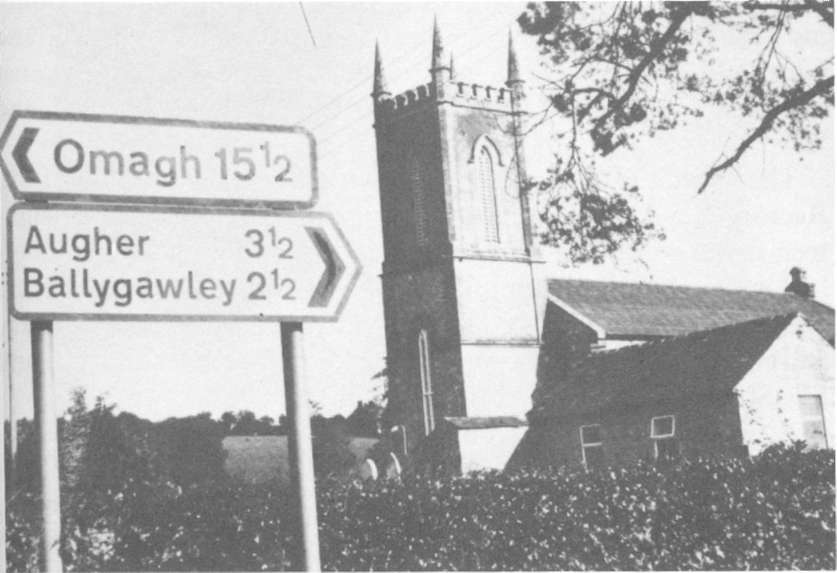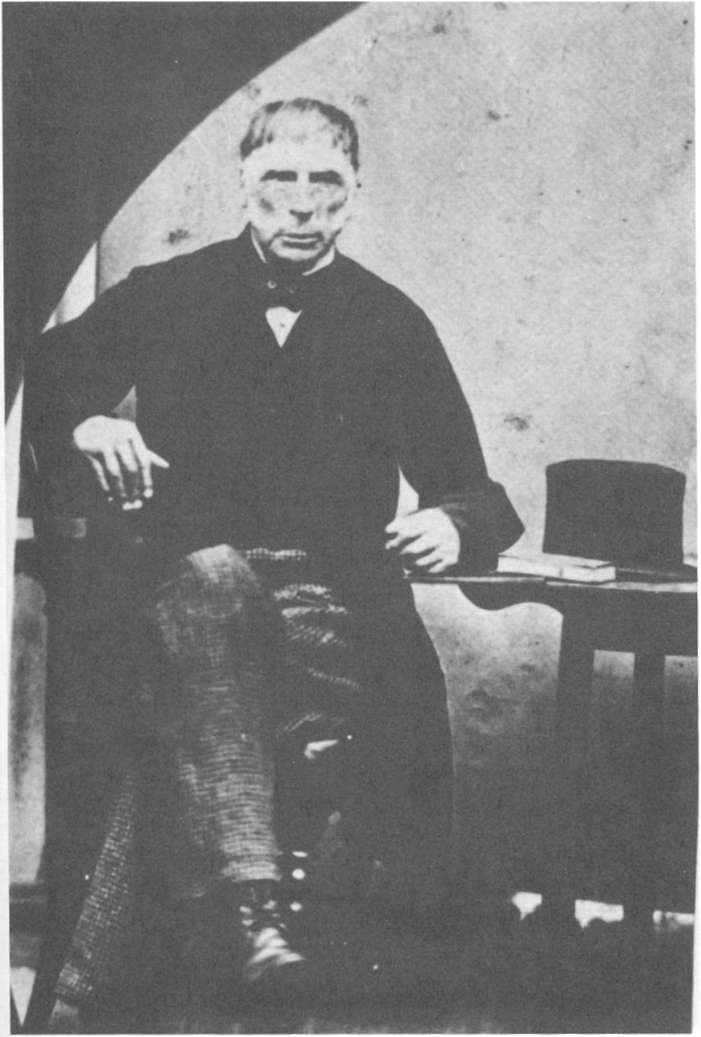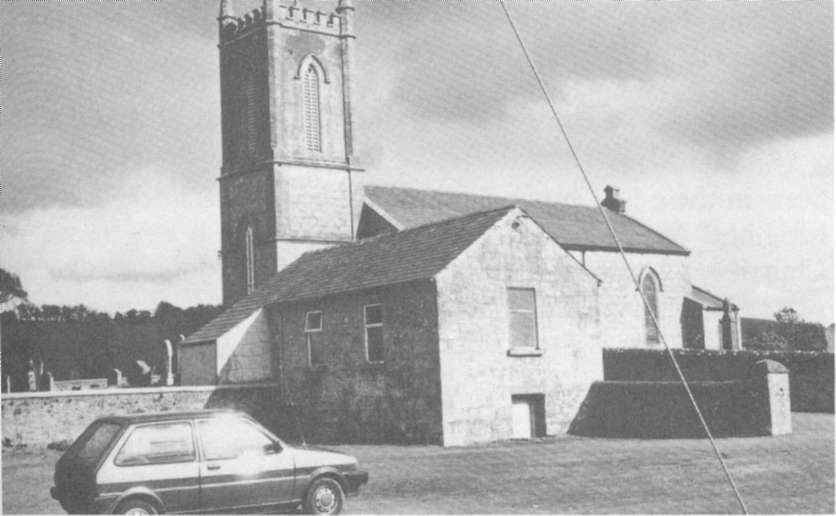The First Evangelist
Pages 224 to 232
| Chapter 7 begins here |
|
First Evangelist "And our eyes at last shall see Him Through His own redeeming love." (from the Ulstercarol, by Tyrone Poetess Fanny Alexander) |
Page 224
KEROG-FOUR was dedicated by the great-grandson of Nichola Hamilton, the Lady who "saw the ghost", the Lady whose father presented the Swedish Chalice to Kerog-Three in 1676.
Three years before the Boyne, Nichola Hamilton married Sir Tristram Beresford. Their great-grandson, Lord John George Beresford was Archbishop of Armagh and Primate of All Ireland for forty years, from 1822 to 1862.
Kerog-Four, built in 1831, was furnished and ready for use by the summer of 1832. On 7th Sept. Archbishop Beresford travelled up from Armagh, and dedicated it to St. Matthew. Beresford, Rector Graham, and the Landlords Stewart and Moutray were blissfully unaware that the parish already had a dedication, blandly accepting the distortion of the Founder's name. Long before he became a Breton Bishop he was styled San-Kerog (St. Kerog).
So it is now the Church of Saints Kerog and Matthew, though the Founder's name is often reserved for the ancient parish, and the 1831 building called for the first Evangelist.
Two years and seven months had passed since the Vestry decided to build a new Church. On Sunday 24th January 1830 Rector Graham's new curate the Rev. J.J. Moutray read out the following announcement in Kerog-Three
"Notice is hereby given to all persons concerned that a Vestry will be held in the Parish Church of the Parish of Errigal Kerogue on
Page 225
Monday the first of February 1830 at the hour of 12 o'clock noon to consider of the building a new Church (sic) for the said parish of Errigal Kerogue on a new and more convenient Site."95
The announcement was repeated on January 31, and the Vestry met the following day. They must have considered the old location convenient enough, for the following resolution was passed— "The Majority of the Vestry have resolved that the new Church is to be built on the townland of Belnasaggart on the part known by the name of Harvey's (?) field, and lately occupied by Alexr Maynes."
To this resolution the Minute Book appends a list of exactly fifty signatures, without any indication whether this was the total attendance, or those of the majority, underwriting their commitment to construct a new building. Here they are, with their domiciles ascertained from other sources
| J. Graham, Rector | Thornhill |
| John Speer, Ch'warden (1772-1848) | Tullybryan |
| Alex'r Falls Hughes, Ch'warden | Ballygawley |
| John Law Speer | Clonally |
| John Buchanan (1782-1855) | Annahilla |
| Robert Simpson Ch'warden in 1846 | Ballinasagart |
| Alexr Moutray (1778-1869) | Ballinasagart |
| Leslie Moutray (1770-1847) | Tullylinton |
| Joseph Ligget jr | Keady |
| John Simpson Ch'warden 1834 | Sess |
| James Robinson | Ballygawley |
| Thomas Happer | Crew |
| Thomas Cooper | Ballylagan |
| Joseph Cumberland | Keady |
| James Smith | Roughan |
| Joseph Simpson | Cess, then B'sagart |
| James Little | Feddin |
| Harvey Happer | Crew |
| Francis Neely | Drumcullion |
| William Little Lismore ? A Collembrone WL. was '36 Warden. | |
| William Smith | Derrymeen |
| Alexander Smyth | Derrymeen |
| David Little | Lismore |
| John Little | Tullylinton or Lettry |
| John English | Lismore |
| John Little | Lettry or Tullylinton |
| James Liggett (1790-1870 | Keady. Had son Davenport, Iowa |
| H.M. Speer -1836 | Balnasagart |
| William Little | Lismore |
| Hugh Moore | Drumcullion |
| George Coghran | Ballynany |
| John Moor | Collembrawn (FK. 1803) |
| John Kirpatrick | Roughan ? 'Kilp' G.S. '56 |
| Henry Giles | Keady |
| David Martin | Lismore |
| Henry Simpson Ch'warden 1837 | Sess |
| Thomas Eagleson | Garvaghy |
| James Turner —1836 | Richmond |
| John Montgomery | Feddin |
| Thomas Hughes | Tullylinton |
| Archibald Irwin | Cavey |
| John Little | Tullylinton or Lettry |
| Patrick Crudden | Ballygawley, ex-Culnaha |
| James McMaster | Ballynany |
| Henry Daily | Mullaghmore |
| John McCoy | Feddin |
| William Giles | Keady |
| John Cumberland | Keady |
| James Speer 1771-1847 | Sess |
| Joseph Liggett | Keady |
Page 226
If these were only the people in favour of a new building, the total attendance must have been 70 or 80. If these are the names of all attending that Monday morning meeting it would be difficult to explain why so many others, some in close proximity didn't attend. Some local families are conspicuous by their absence from this list. Probably they were present, but for some unrecorded reason did not support the proposal to build a new Church.
Page 227
 |
Then another question arises. The decision to build was taken on 1st Feb. A loan of £ 1,100 was available from the Board of First Fruits by the beginning of April. Indeed the Vestry authorised the first instalment (£ 44) of repayment on April 12. Yet, nearly half a year passed before a Committee was set up to proceed with the project.
The implementation of that Feb. decision could have been got under way directly, or at the latest in April. It was on 9th Aug. that "a Meeting was held in the Church of the Parish of Errigle Keeroge. The following Committee has been appointed for making arrangements relative to building the new Church"
John Cony Moutray
Sir Hugh Stewart
Revd James Graham
Thomas Simpson
J.L. Speer
Why the delay? How were local attitudes affected by the revolutionary ferment of that year? How apprehensive was the local
Page 275
aristocracy about the approaching Great Reform Bill? The Building Committee consisted of the Landlords of Favor Royal and Greenhill, the two Churchwardens, and the Rector. Thomas Simpson of Bloomhill was Churchwarden in 1821, '30, '42, and '47.
The Building Committee had two advantages over the 1960 Rectory Building Committee. Consisting of five instead of eighteen it was more easily convened, and secondly, all five members had experience of building. Sir Hugh Stewart had renovated and extended the old Harvey residence at Greenhill. Corry Moutray had just completed the complete rebuilding of Favor Royal, and J.L. Speer had in 1828 rebuilt Clonully Mill.
Apart from the five on the Building Committee, only three others attended this Meeting—Alexander Moutray and Joseph Simpson of Ballinasagart, and the young curate-assistant J.J. Moutray, son of Corry Moutray. Where was the rest of Kerog Vestry? Where were the 50 or perhaps 80 who thronged that Monday morning meeting six months earlier? Were those February signatories having second thoughts?
Sandy Moutray's attitude is an enigma. A heavy line separates his name from those of the Committee. He had in 1812 built himself, at the north-west corner of the townland, the fine house that still stands 170 years later. When the question was first mooted, three years earlier, he was not in favour of a new Church. One of the Vestrymen in a letter to Archbishop Beresford after that 1827 meeting said "One of the Churchwardens, Mr. Alexander Moutray, would neither be present, or a party to" the project. Sandy's first cousin, Laird Corry Moutray explained Sandy's absence from that historic meeting with the words "Mr. Alexander Moutray did not attend, because he particularly wished to be considered totally indifferent about the building or removal of the Church." * 96
Four days after the Committee was set up an advertisement was sent to the Northern Whig (Belfast)
Proposals for Building a Church, in the Parish of Errigle Keerogue, in the Diocese of Armagh, and County of Tyrone, will be received till the First of September, addressed to John Law Spear, Esq.,
Page 229
 |
Clean-Alley, Ballygawley, who will show the Plans and Specifications
August 13, 1830
The Plans and Specifications are not extant, and the Kerog Account Book makes payments to the Architect, without identifying him. William Warren of Lissadell, Sligo had designed Clogher Palace
Page 230
in 1817, Calry Church in 1824, and Augher Castle in 1831. In 1831 the Kerog Account Book records one pound paid "to Joseph Liggett, by Mr. Warren's order which charged for plan of Schoolhouse." If the word "he" was intended after "which" it means that Warren supplied Liggett with the drawings for the schoolhouse, and that Warren was passing on this small gratuity for some reason to the Builder.
The two-storey schoolhouse, which is now a tiny Parish Hall, is a simple structure. Liggett could "run it up" without elaborate plans. It is unlikely that an architect of Warren's calibre would involve himself, unless he was simultaneously engaged on something more elaborate nearby. If Warren was planning Kerog-Four when Liggett was preparing to construct the Schoolhouse, Liggett may have asked him for a few tips, and architectural sketches. When the Churchwardens were paying him for the Church plans, they would ask what they owed for the school plans. Warren might quote the nominal one pound, and tell them to pass it on to Liggett.
Then, on 18th Sept. 1832, eleven days after St. Matthew's was dedicated Kerog Vestry met specifically "for the purpose of settling the Architect's Account—relative to the new Church, as there appears to be due to him £ 50-4-7, for extra work, over and above his contract." If the excess alone was £ 50, his contract must have been considerable, indicating someone of Warren's achievement and reputation. Then in October 1974, no less an authority than Hugh Dixon, after a meticulous survey of the fabric of Kerog Church certified that its fine proportions had unmis-takeable Warren characteristics.
The Committee also advertised in the Newry Telegraph. A Mr. Robinson, and a Mr. Stewart were paid half-a-crown and six and ninepence halfpenny for new Church adverts. The Whig advert cost £1-11-6, and the Newry Telegraph £1-0-6. Then Hazelton of Ballygawley was paid twelve shillings for "engrossing the Deeds between the Churchwardens and Mr. Clarke". The Minute Book is just as tantalizing about the identity of the
Page 231
 |
Builder. Perhaps he was paid directly by the Board of First Fruits. There is a cryptic Account Book entry on 22nd June 1832 of £16-l-3½ for "Crimson cloth, fringe, stuff etc. as of acct furnished by Mr. Peebles." The Minute Book reference to this payment is briefer and more pointed "To Mr. Peebles Account for the new Church". This was probably Peebles of Killycorran, Clogher, a qualified engineer, responsible for much of the large scale building in the district. He owned some land in Keady townland, half a mile south of Kerog Church where lived Joe Liggett last of the fifty signatories.
The actual construction was probably done in the summer and autumn of 1831. It was certainly up by Easter 1832. The Minute Book records on 24th April 1832 "rent for the ground on which the new Church stands." The only other 1831 reference to the project concerns rent paid for the strip of land taken for the new Church, and one pound to purchase a field nearby.
In 1832 the Churchwardens fitted out the new Church with
| Pew Doors | £10-l0-0 |
| Coarse linen and wool, for stuffing cushions and stools—also nails | £1-0-3½ |
| Cloth | 16-1-3 |
| A. Mayne for making fringe | 3-0 |
| Sundries | 2-10-3½ |
| Anne McCoy for work in new Church | 1-10-0 |
| Paid Corry Moutray for 2 cwt. Church Bell | 20-10-6 |
Page 232
On 21st Sept. 1832 we read "Vestry disposes (allocates ?) of Seats in the new Church." In 1833 the Wardens got a "gate and hangings" for 8 shillings and tenpence. In 1836 a "gate for the Churchyard" cost 10 shillings. In 1833 Messrs John McCoy and Peter Flanagan got £8-6-4 and £8-8-4 for "building the wall" £16-5-8.
It is very difficult to detect what patches of ground are indicated by the hazy references to the composition of St. Matthew's site in the Account and Minute Books. There seem to be four patches involved
- The site and restricted environs of Kerog-Three, already owned— apparendy since 1622.
- The McKenna strip, rented for at least forty years, to "enlarge the Churchyard" and eventually acquired.
- "Harvies" (?) field owned by James Speer's executors rented per Edw Beatty from Mar. 1830, and grazed by Mayne
- Half an acre purchased for one pound in 1831.
Fabric, furnishings, and environs were completed by 1840, just ten years after the decision to build, when Stewart Simpson was paid four shillings and sixpence "for boards and nails for a stool for the pulpit", and a "Churchwardens Guide", possibly a handbook, for ten shillings and sixpence.
The ground must have been muddy the following winter when the Churchwardens bought two shillings worth of gravel from John Donolly. But the laying of the path must have been a voluntary job, because the Churchwardens supplied refreshments for the workers, and on 4th May 1841 paid Stewart Simpson no less than Three pounds, Two shillings, and Ten pence "For bread and liquor expended at making the gravell'd walk round the Church"!!!
| Chapter 7 ends on Page 271 |